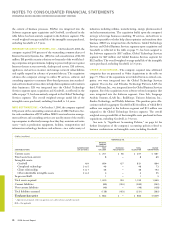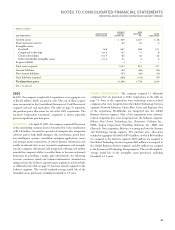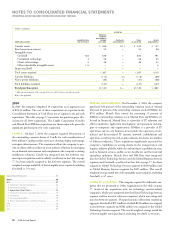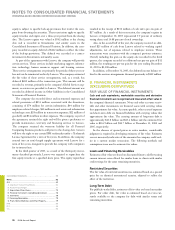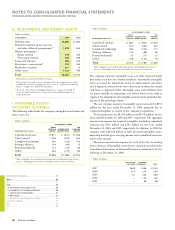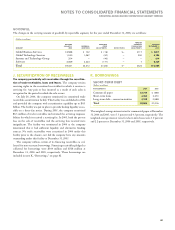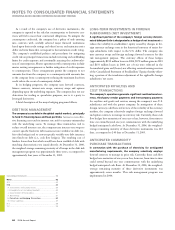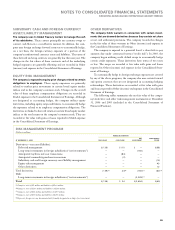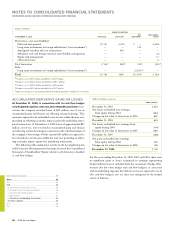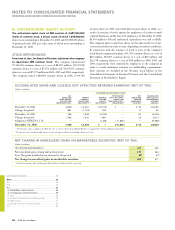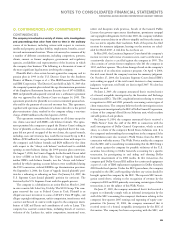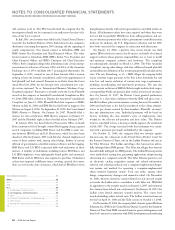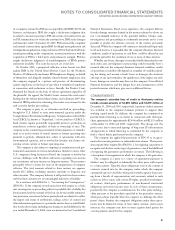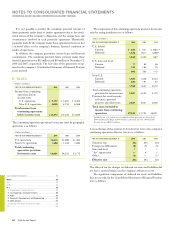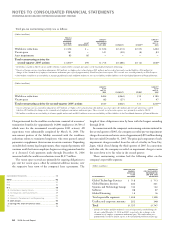IBM 2006 Annual Report Download - page 86
Download and view the complete annual report
Please find page 86 of the 2006 IBM annual report below. You can navigate through the pages in the report by either clicking on the pages listed below, or by using the keyword search tool below to find specific information within the annual report.
As a result of the company’s use of derivative instruments, the
company is exposed to the risk that counterparties to derivative con-
tracts will fail to meet their contractual obligations. To mitigate the
counterparty credit risk, the company has a policy of only entering
into contracts with carefully selected major financial institutions
based upon their credit ratings and other factors, and maintains strict
dollar and term limits that correspond to the institution’s credit rating.
The company’s established policies and procedures for mitigating
credit risk on principal transactions include reviewing and establishing
limits for credit exposure and continually assessing the creditworthi-
ness of counterparties. Master agreements with counterparties include
master netting arrangements as further mitigation of credit exposure
to counterparties. These arrangements permit the company to net
amounts due from the company to a counterparty with amounts due
to the company from a counterparty reducing the maximum loss from
credit risk in the event of counterparty default.
In its hedging programs, the company uses forward contracts,
futures contracts, interest-rate swaps, currency swaps and options
depending upon the underlying exposure. The company does not use
derivatives for trading or speculative purposes, nor is it a party to
leveraged derivatives.
A brief description of the major hedging programs follows.
DEBT RISK MANAGEMENT
The company issues debt in the global capital markets, principally
to fund its financing lease and loan portfolio. Access to cost-effec-
tive financing can result in interest rate and/or currency mismatches
with the underlying assets. To manage these mismatches and to
reduce overall interest cost, the company uses interest-rate swaps to
convert specific fixed-rate debt issuances into variable-rate debt (i.e.,
fair value hedges) and to convert specific variable-rate debt issuances
into fixed-rate debt (i.e., cash flow hedges). The resulting cost of
funds is lower than that which would have been available if debt with
matching characteristics was issued directly. At December 31, 2006,
the weighted-average remaining maturity of all swaps in the debt risk
management program was approximately three years, as compared to
approximately four years at December 31, 2005.
NOTES TO CONSOLIDATED FINANCIAL STATEMENTS
INTERNATIONAL BUSINESS MACHINES CORPORATION AND SUBSIDIARY COMPANIES
84 2006 Annual Report
LONG-TERM INVESTMENTS IN FOREIGN
SUBSIDIARIES (NET INVESTMENT)
A significant portion of the company’s foreign currency denomi-
nated debt portfolio is designated as a hedge of net investment to
reduce the volatility in stockholders’ equity caused by changes in for-
eign currency exchange rates in the functional currency of major for-
eign subsidiaries with respect to the U.S. dollar. The company also
uses currency swaps and foreign exchange forward contracts for this
risk management purpose. The currency effects of these hedges
(approximately $350 million losses in 2006, $570 million gains in 2005
and $156 million losses in 2004, net of tax) were reflected in the
Accumulated gains and (losses) not affecting retained earnings section
of the Consolidated Statement of Stockholders’ Equity, thereby offset-
ting a portion of the translation adjustment of the applicable foreign
subsidiaries’ net assets.
ANTICIPATED ROYALTIES AND
COST TRANSACTIONS
The company’s operations generate significant nonfunctional cur-
rency, third-party vendor payments and intercompany payments
for royalties and goods and services among the company’s non-U.S.
subsidiaries and with the parent company. In anticipation of these
foreign currency cash flows and in view of the volatility of the currency
markets, the company selectively employs foreign exchange forward
and option contracts to manage its currency risk. Currently, these cash
flow hedges have maturities of one year or less, however, from time to
time can extend beyond one year commensurate with the underlying
hedged anticipated cash flows. At December 31, 2006, the weighted-
average remaining maturity of these derivative instruments was 216
days, as compared to 240 days at December 31, 2005.
ANTICIPATED COMMODITY
PURCHASE TRANSACTIONS
In connection with the purchase of electricity for anticipated
manufacturing requirements, the company selectively employs
forward contracts to manage its price risk. Currently, these cash flow
hedges have maturities of one year or less, however, from time to time
could extend beyond one year commensurate with the underlying
hedged anticipated cash flows. At December 31, 2006, the weighted-
average remaining maturity of these derivative instruments was
approximately seven months. This risk management program was
implemented in 2006.
Consolidated Statements .........................................................
Notes .....................................................................................
A-G ......................................................................................... 62
H-M .........................................................................................
H. Investments and Sundry Assets ......................................
I. Intangible Assets Including Goodwill ...............................
J. Securitization of Receivables ...........................................
K. Borrowings .......................................................................
L. Derivatives and Hedging Transactions ............................
M. Other Liabilities ...............................................................
N-S ..........................................................................................
T-X ..........................................................................................
Black
MAC
390 CG10


